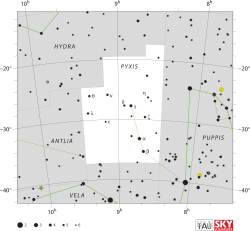HD 72673
HD 72673 (11 G. Pyxidis) är en ensam stjärna belägen i den mellersta delen av stjärnbilden Kompassen. Den har en skenbar magnitud av ca 6,38[2] och är mycket svagt synlig för blotta ögat där ljusföroreningar ej förekommer. Baserat på parallaxmätning inom Hipparcosuppdraget på ca 81,9[2] mas, beräknas den befinna sig på ett avstånd på ca 40 ljusår (ca 12 parsek) från solen. Den rör sig bort från solen med en heliocentrisk radialhastighet på ca 82 km/s.[5]
| HD 72673 | |
 | |
| Observationsdata Epok: J2000.0 | |
|---|---|
| Stjärnbild | Kompassen |
| Rektascension | 08t 32m 51,49609 s[1] |
| Deklination | -31° 30′ 03,0717 ″[1] |
| Skenbar magnitud () | +6,38 (V)[2] |
| Stjärntyp | |
| Spektraltyp | G9 V[3] |
| U–B | +0,29[4] |
| B–V | +0,78[4] |
| Astrometri | |
| Radialhastighet () | +81,91[5] km/s |
| Egenrörelse (µ) | RA: -1 113,37[5] mas/år Dek.: +761,57[1] mas/år |
| Parallax () | 81,91 ± 0,46[1] |
| Avstånd | 39,8 ± 0,2 lå (12,21 ± 0,07 pc) |
| Absolut magnitud () | +5,95[2] |
| Detaljer | |
| Massa | 0,750 ± 0,015[6] M☉ |
| Radie | 0,85[7] R☉ |
| Luminositet | 0,44[8] L☉ |
| Temperatur | 5 290[9] K |
| Metallicitet | -0,36 (Fe/H)[9] dex |
| Vinkelhastighet | 6,79[10] km/s |
| Ålder | 5,7 – 6,5[2] miljarder år |
| Andra beteckningar | |
| LHS 249, CD-31 6229, CPD-31 2448, GJ 309, HD 72673, HIC 41926, HIP 41926, HR 3384, IRAS 08308-3120, 2MASS J08325148-3130031, NLTT 19772, PLX 2042, PPM 285366, SAO 199352, TYC 7135-2774-1, uvby98 100072673, WISEA J083250.57-312955.0, Gaia DR2 5640565607657897728, Gaia DR1 5640553955399933824 [11] | |
Egenskaper redigera
HD 72673 är en solliknande gul till vit stjärna i huvudserien av spektralklass G9 V.[3] Den har en massa som är ca 0,75[6] solmassor, en radie som är ca 0,85[7] solradier och har ca 0,44 gånger solens utstrålning av energi[8] från dess fotosfär vid en effektiv temperatur av ca 5 300 K.[9]
HD 72673 är ungefär sex[9] miljarder år gammal och roterar långsamt med en period på ca 40 dygn. Ytmagnetisk aktivitet med en periodisk cykel av 3 050+558 −408 dygn har observerats.[12] Stjärnan har undersökts för bevis på en omgivande stoftskiva eller planeter, men fram till 2012 har ingen upptäckts.[13]
Referenser redigera
- Den här artikeln är helt eller delvis baserad på material från engelskspråkiga Wikipedia, HR 3384, 21 juli 2021.
Noter redigera
- ^ [a b c d] van Leeuwen, F. (2007), "Validation of the new Hipparcos reduction", Astronomy and Astrophysics, 474 (2): 653–664, arXiv:0708.1752, Bibcode:2007A&A...474..653V, doi:10.1051/0004-6361:20078357, S2CID 18759600Vizier catalog entry
- ^ [a b c d e] Mamajek, Eric E.; Hillenbrand, Lynne A. (November 2008), "Improved Age Estimation for Solar-Type Dwarfs Using Activity-Rotation Diagnostics", The Astrophysical Journal, 687 (2): 1264–1293, arXiv:0807.1686, Bibcode:2008ApJ...687.1264M, doi:10.1086/591785, S2CID 27151456
- ^ [a b] Gray, R. O.; et al. (July 2006), "Contributions to the Nearby Stars (NStars) Project: spectroscopy of stars earlier than M0 within 40 pc-The Southern Sample", The Astronomical Journal, 132 (1): 161–170, arXiv:astro-ph/0603770, Bibcode:2006AJ....132..161G, doi:10.1086/504637, S2CID 119476992
- ^ [a b] Mermilliod, J.-C. (1986), "Compilation of Eggen's UBV data, transformed to UBV (unpublished)", Catalogue of Eggen's UBV Data, SIMBAD, Bibcode:1986EgUBV........0M
- ^ [a b c] Nidever, David L.; et al. (August 2002), "Radial Velocities for 889 Late-Type Stars", The Astrophysical Journal Supplement Series, 141 (2): 503–522, arXiv:astro-ph/0112477, Bibcode:2002ApJS..141..503N, doi:10.1086/340570, S2CID 51814894
- ^ [a b] Tsantaki, M.; et al. (July 2013), "Deriving precise parameters for cool solar-type stars. Optimizing the iron line list", Astronomy & Astrophysics, 555: A150, arXiv:1304.6639, Bibcode:2013A&A...555A.150T, doi:10.1051/0004-6361/201321103, S2CID 118388752.
- ^ [a b] Pasinetti Fracassini, L. E.; et al. (February 2001), "Catalogue of Apparent Diameters and Absolute Radii of Stars (CADARS) - Third edition - Comments and statistics", Astronomy and Astrophysics, 367 (2): 521–524, arXiv:astro-ph/0012289, Bibcode:2001A&A...367..521P, doi:10.1051/0004-6361:20000451, S2CID 425754.
- ^ [a b] Anderson, E.; Francis, Ch. (2012). "XHIP: An extended hipparcos compilation". Astronomy Letters. 38 (5): 331. arXiv:1108.4971. Bibcode:2012AstL...38..331A. doi:10.1134/S1063773712050015. S2CID 119257644. Vizier catalog entry
- ^ [a b c d] Ramírez, I.; et al. (February 2013), "Oxygen abundances in nearby FGK stars and the galactic chemical evolution of the local disk and halo", The Astrophysical Journal, 764 (1): 78, arXiv:1301.1582, Bibcode:2013ApJ...764...78R, doi:10.1088/0004-637X/764/1/78, S2CID 118751608
- ^ Martínez-Arnáiz, R.; et al. (September 2010), "Chromospheric activity and rotation of FGK stars in the solar vicinity. An estimation of the radial velocity jitter" (PDF), Astronomy and Astrophysics, 520: A79, arXiv:1002.4391, Bibcode:2010A&A...520A..79M, doi:10.1051/0004-6361/200913725, S2CID 43455849
- ^ HR 3384 (u-strasbg.fr) |Hämtad 2021-07-21.
- ^ Karatas, Y.; Schuster, W. J. (October 2006), "Metallicity and absolute magnitude calibrations for UBV photometry", Monthly Notices of the Royal Astronomical Society, 371 (4): 1793–1812, Bibcode:2006MNRAS.371.1793K, doi:10.1111/j.1365-2966.2006.10800.x.
- ^ Maldonado, J.; Eiroa, C.; Villaver, E.; Montesinos, B.; Mora, A. (May 2012), "Metallicity of solar-type stars with debris discs and planets", Astronomy & Astrophysics, 541: 10, arXiv:1202.5884, Bibcode:2012A&A...541A..40M, doi:10.1051/0004-6361/201218800, S2CID 46328823, A40.



